
While the mobile storytelling and artificial intelligence revolutions carry megaphones and shout loudly, the print revolution is nuanced, but present.
Surprised? Me, too, but only a little bit, since I sit in many conference rooms on the first day of a digital project and hear a top media executive give me a warning: “Print is still quite important here, Mario, and a sort of cash cow.”
If you look at the most recent data on printed newspapers and magazines, the arrows all point down. And nowhere is this more prevalent than with local news, a mainstay for survival of small and size newspapers. According to Pew Research studies, “More Americans now prefer to get local news online, while fewer turn to TV or print.” The 2024 Pew study reveals that, when it comes to local news, Americans get 32% of that content from TV, 48% from websites and social media, and 9% from print and 9% from radio.
In 2018, when a previous study was conducted, 13% preferred to get local news from print.
This may be why approximately 2,100 local newspapers have closed since 2004, affecting 1,800 communities. However, some of the major newspaper brands still have respectable print numbers:
- In 2023, the average weekday print circulation of The New York Times was approximately 279,000 copies, less than half the figure recorded in 2014.
- As of August 2023, The Wall Street Journal had over 3.9 million in total circulation, with 3.4 million from digital-only subscriptions.
Quiet revolution is global
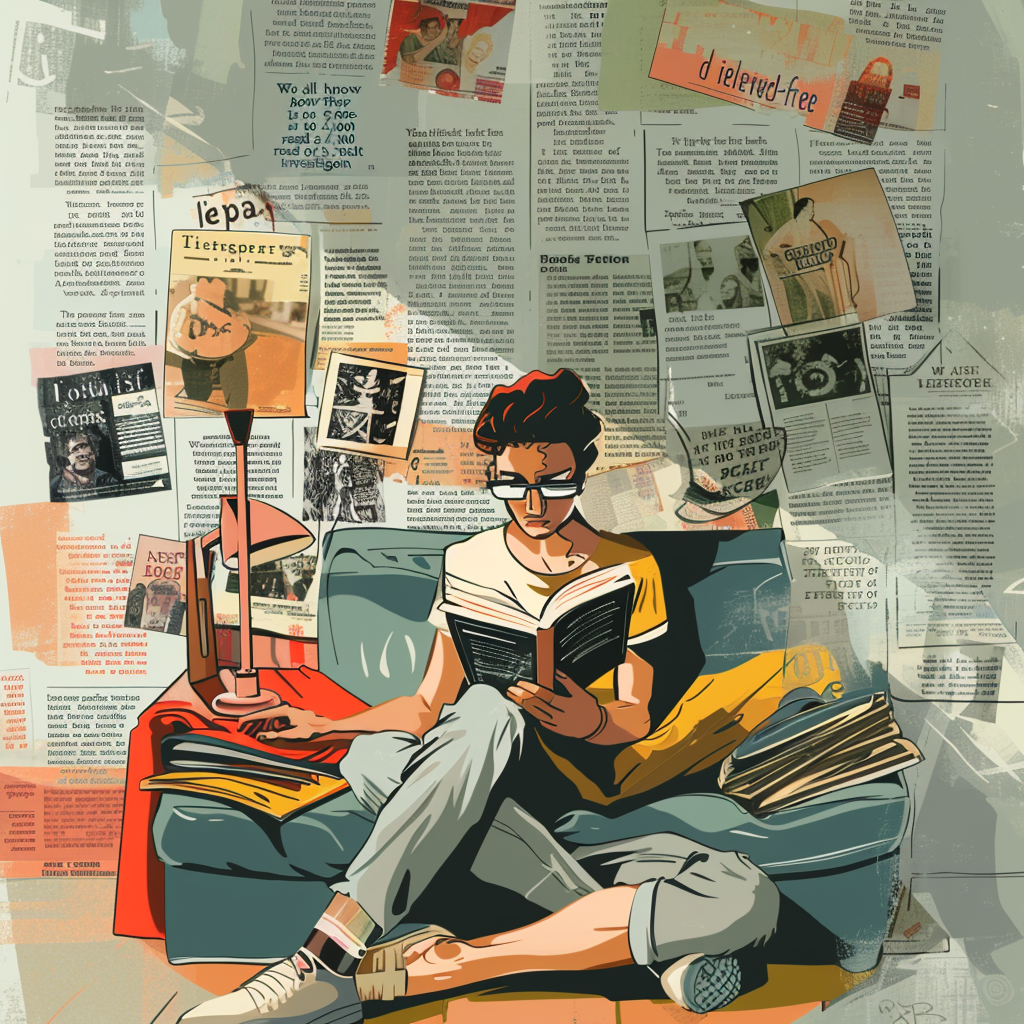
I always reassure my clients that I, too, like print and know how important it can be, especially when I am working in India and Latin America. However, the “quiet revolution” that I mentioned earlier is not limited to those geographic global spots. I hear it in Europe.
Most recently, in the United States, Brad Stone, editor of Businessweek, said he believes print journalism could make a comeback as the 95-year-old title moved from weekly to monthly circulation this week. Businessweek’s latest print edition includes 120 pages, with emphasis on the long read.
“I’m a believer in the leaned-back, distraction-free luxury of print. And I do think that there’s a place for it and maybe even we’ll see a bit of a comeback, ” Stone said. “We all know how difficult it is to sit there and read a 4,000 or 5,000-word investigation online, even on a story or a topic we care about. But people say they want that. You know, we’re living in a chaotic and confusing world where we need more of that kind of storytelling and not less. So I do think there’s a place for print.”
Meanwhile, outdoor print magazines are having their day in the sun, too, according to a piece in The New York Times:
“There are sprouts of life, even profitability, on the landscape of print media and magazines, cratered by the pixilated bombardment of the digital age. High-end niche periodicals are popping up, but the trend might be most evident in a burst of small-batch, independent outdoors magazines like Adventure Journal, Mountain Gazette, Summit Journal and Ori. They are crowding into quiet spaces of narrow lanes — climbing, surfing, skiing, running and the like — where quality is key, advertising is minimal and subscribers are faithful. Most do not put their content online; this is journalism meant to be thumbed through, not swiped past.
“The magazines are sometimes oversized and increasingly matte finished, filled with edge-to-edge photographs and literary heaves. They can cost $25 or more per issue. They are meant as much for the coffee table as the shoulder bag — designed to be collectible, not disposable.”
These niche magazines often feature oversized formats, matte finishes, and edge-to-edge photography. They are priced at a premium, sometimes exceeding $25 per issue, and are intended for display on coffee tables as much as for reading. Their content is typically not available online, reinforcing their exclusive, collectible nature. These magazines cater to specific interests such as climbing, surfing, skiing, and running, emphasizing quality content with minimal advertising. They are designed to be collectible items rather than disposable reads.
How about this headline for a piece that I have copied and sent to several of my clients:
Why print won’t lie down and die
“Here we are in 2024… almost a quarter of the way through a new century… still printing magazines, still making money from them,” writes Peter Houston for The Magazine Diaries from Grub Street.
Indeed, we are. For how long? Nobody will put an expiration date on print. Neither will I, because I think that print publications will exist in some form forever.
Houston notes that despite the digital age’s challenges, print media continues to thrive and generate revenue. Houston’s observations align with the broader sentiment that print publications will persist in some form indefinitely.
Justifying print editions
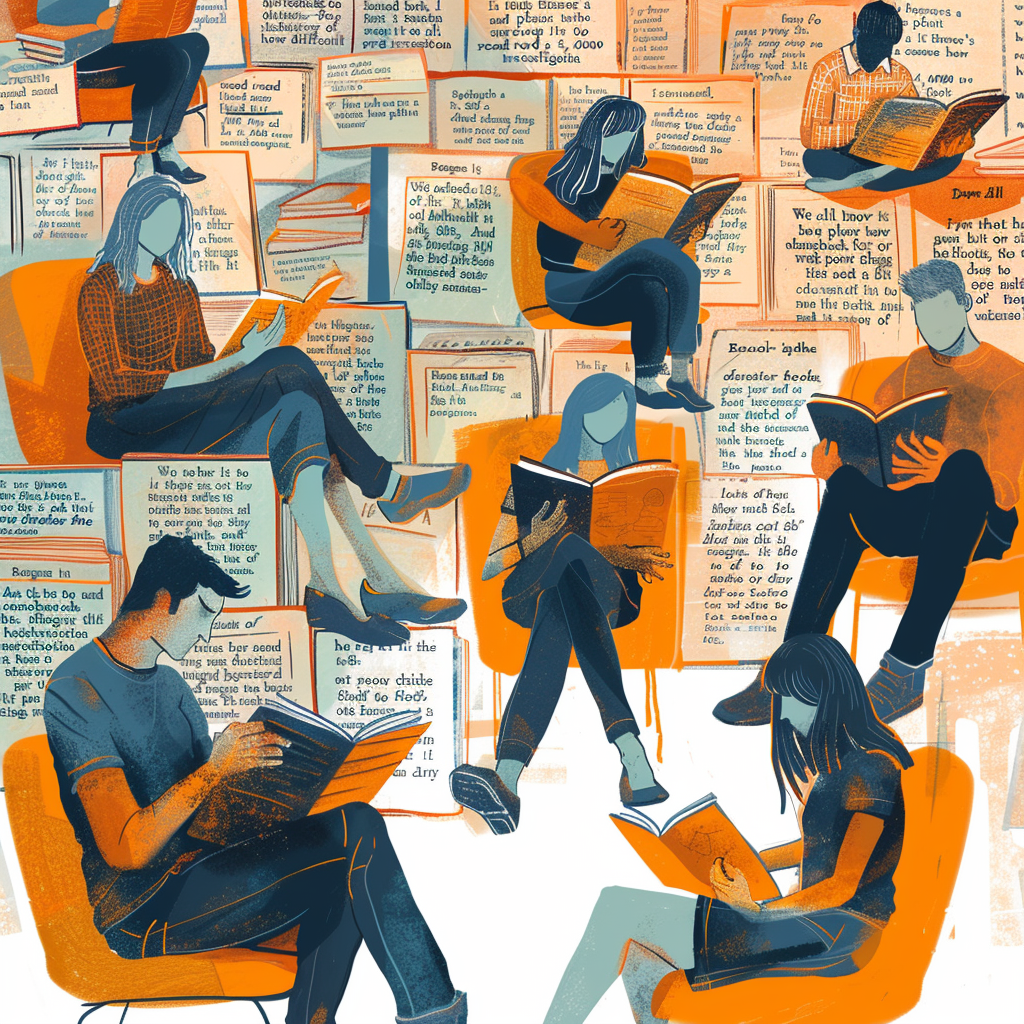
The profitability of print media, particularly in niche markets, demonstrates its economic viability. These publications attract a dedicated readership willing to pay a premium for quality content and a tactile reading experience.
These niche magazines often feature oversized formats, matte finishes, and edge-to-edge photography. They are priced at a premium, sometimes exceeding $25 per issue, and are intended for display on coffee tables as much as for reading. Their content is typically not available online, reinforcing their exclusive, collectible nature.
Leaning Back is welcome: I believe that the resurgence of print is driven by a growing audience of lean-back readers who value the immersive, distraction-free experience that print offers. As media houses adapt to these changing preferences, print media is likely to continue its quiet revolution, carving out a sustainable niche in the modern media ecosystem.
My current projects
How is this quiet print revolution manifesting itself in my current projects? For example, I am involved in projects where a redesign of the entire brand begins with an assessment of the print product——an exercise I recommend for anyone with a strong print base. I also sense that media executives s are , for the first time since the digital era began , re-evaluating the role of print and giving it its due—with that comes tweaks, redesigns, and the interaction of digital influencing print and vice versa—emphasis on the latter.
In addition, I see more repositioning of print editions, not as breaking news platforms within the brand, but as the home of long pieces and big photos and illustrations.
In one of my most recent projects, a weekly magazine, we did a total rethink of the print edition first. Now, almost a year later, we are approaching the digital redesign, starting by combing through the very successful print redesign and making note of those elements that we must replicate digitally. It is not always a 100% transfer, but it is organic and whatever ends up in the digital edition has its roots in the print product.
This quiet print revolution may get a bit louder in the months ahead.
For more on this topic:
https://www.pewresearch.org/journalism/2024/05/07/americans-changing-relationship-with-local-news/
https://redline.digital/us-newspapers-statistics/
https://magazinediaries.substack.com/p/why-print-wont-lie-down-and-die
https://www.statista.com/statistics/273503/average-paid-weekday-circulation-of-the-new-york-times/
Our workshop deals with the two big revolutions facing editors
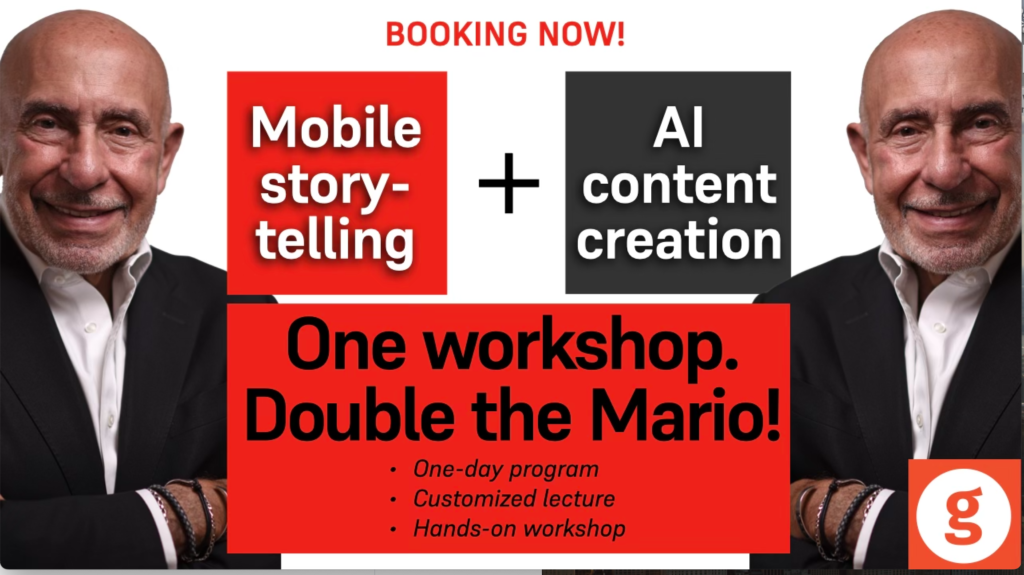
For me, it is imperative that editors approach content creation thinking in terms of mobile first.
Mobile first involves the type of transformation where all content is prepared thinking from small to large platform. Thinking small platform does not mean that the reporter conceptualizing a story for mobile consumption should not think BIG. So, plan from small to large, but think big in terms of the story content and the visual assets that go with it.
While mobile first is still elusive to so many newsrooms around the planet, here we are, in 2024, faced with an even bigger challenge not just knocking at our doors, but already IN: Artificial Intelligence.
Transformation and a change of mentality to face these challenges is the first step. Training and education to tackle them with a sense of focus and direction is essential.
That’s where our Garcia Media workshops come in
Our Garcia Media Mobile Storytelling workshops introduce your editorial team to the way we write, edit and design for mobile platforms. This one-day program includes a presentation and a hands-on workshop. We’ve added a new segment about AI for content creation.
For details, to customize, and to book: mario@garciamedia.com
Order my new book AI: The Next Revolution for Content Creation:
Join me on the road:
Appearances and conference
https://linktr.ee/themarioblog (https://linktr.ee/themarioblog)
Mario’s AI speaking engagements coming up
Here you see where I will be discussing AI at various events. Feel free to send me an email (mario@garciamedia.com) if you have questions about any of these events. You can always go directly to the organization’s website for additional information.

Hoping to see you along the way!
Artificial Creative Intelligence blogs of interest:
The following blog posts all deal with Artificial Intelligence and creativity:
Media predictions for 2024
Every year, Harvard University’s Nieman Lab publishes what selected media people predict for journalism in the following years. You can find my own prediction here;
https://www.niemanlab.org/2023/12/ai-takes-center-stage/
Start writing or type / to choose a block
How we use AI
Honored to be mentioned here:
https://www.newsroomrobots.com/p/how-10-news-industry-leaders-use
Order my new AI book here:
https://thaneandprose.com/…/preorder-ai-what-to-expect…
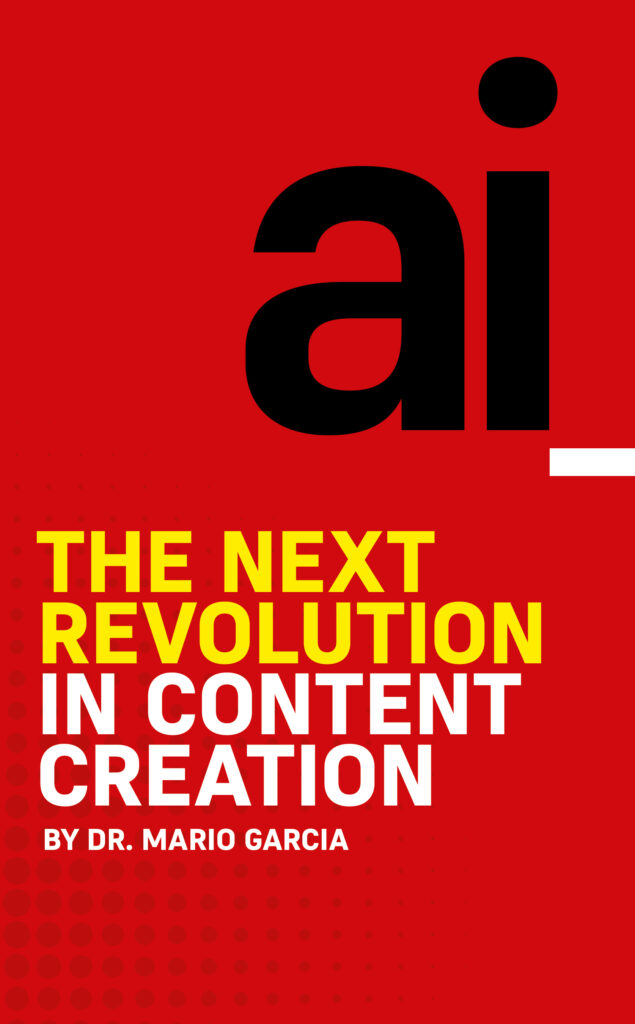
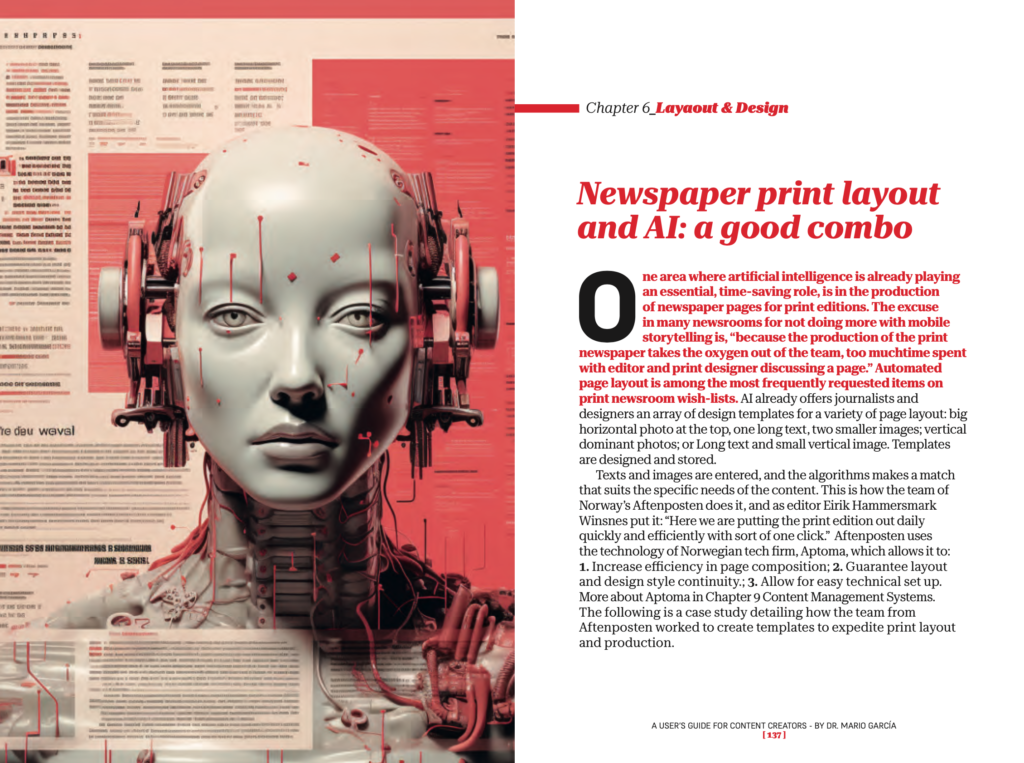


Here is a chance to pre-order my new book about Artificial Intelligence and content creation. The first 25 copies sold will be signed! Order here:
https://thaneandprose.com/…/preorder-ai-what-to-expect…
Reviews for AI book:
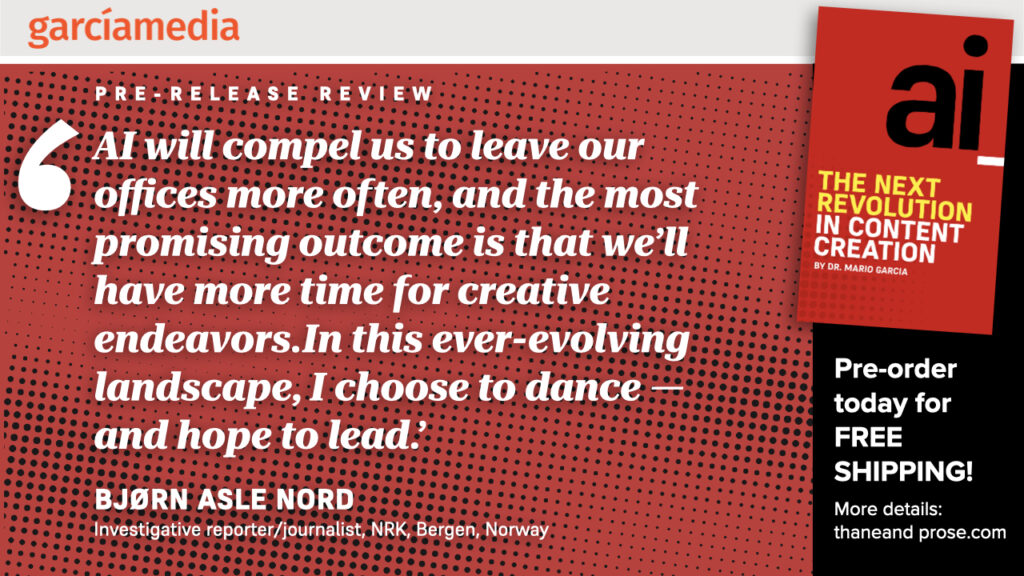
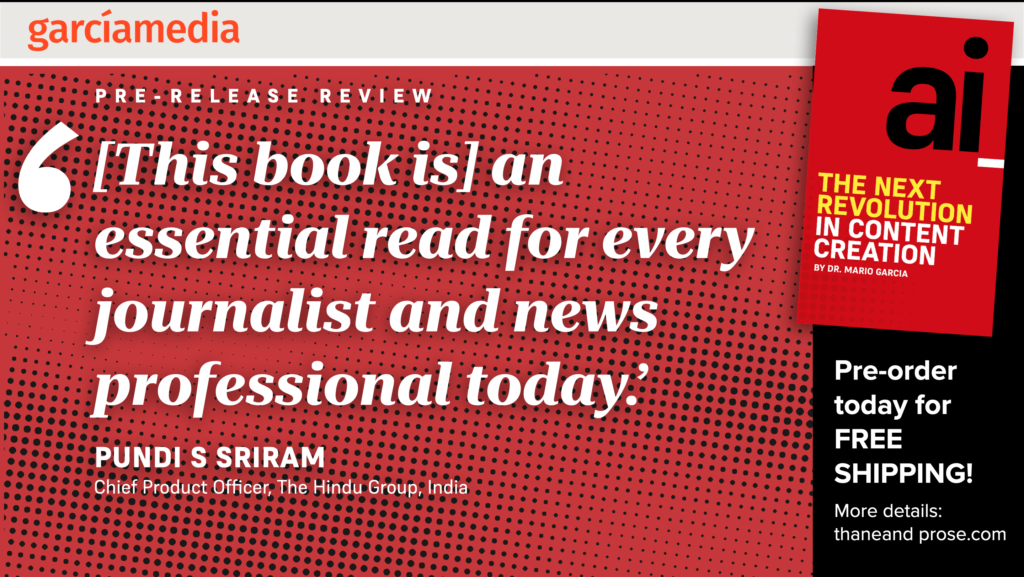


Newsrooms around the planet have gone mobile-first after a Garcia Media workshop!
Our Garcia Media Mobile Storytelling workshops are proven to introduce your editorial team to the way we write, edit and design for mobile platforms. It is a one-day program that involves a presentation (where I summarize my Columbia University class content), and follow it with a hands on workshop.
Did you read The Story yet?
I urge you to consult my latest book, The Story, a trilogy full of tips and explanations about mobile storytelling, which represents the latest genre for journalists to explore. See information below:
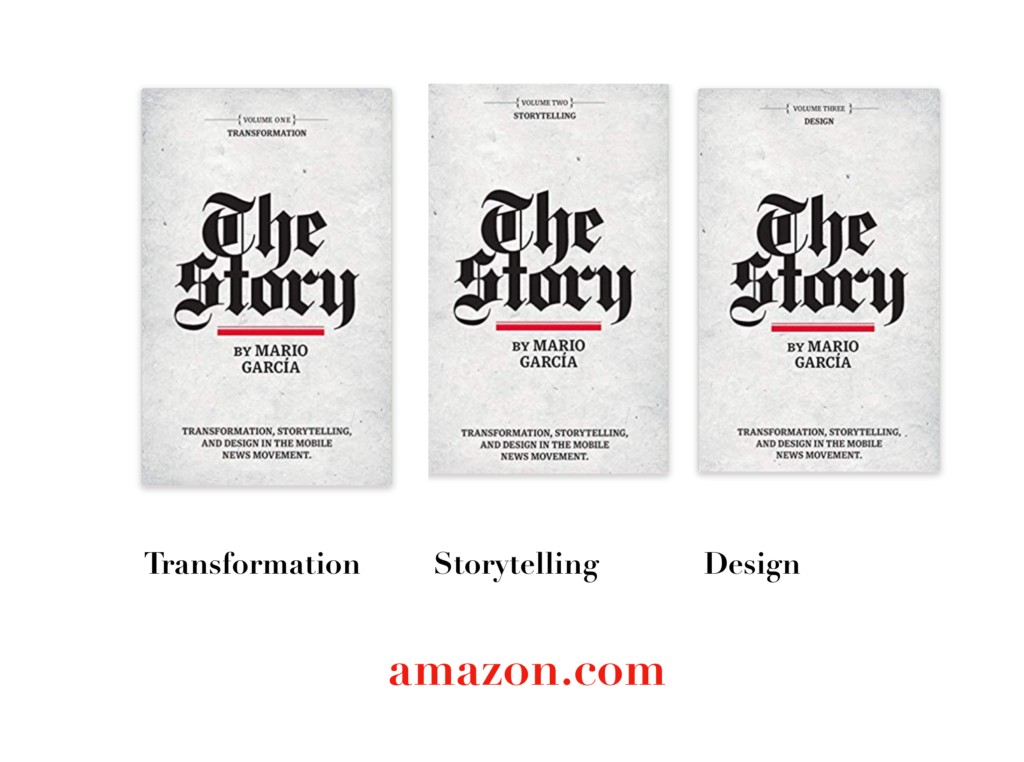
The full trilogy of The Story now available–3 books to guide you through a mobile first strategy. Whether you’re a reporter, editor, designer, publisher, corporate communicator, The Story is for you! https://amazon
Volume 1: Transformation
https://books.apple.com/us/book/the-story-volume-i/id1480169411
Volume Two: Storytelling
https://books.apple.com/us/book/the-story-volume-ii/id1484581220
Volume Three: Design
https://books.apple.com/us/book/the-story-volume-iii/id1497049918
Order the print edition of The Story, from Amazon, here:
TheMarioBlog post #3396